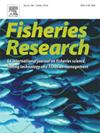Representative sampling by fishers in a reference fleet programme
IF 2.2
2区 农林科学
Q2 FISHERIES
引用次数: 0
Abstract
Fisheries catch sampling is often done using non-probabilistic methods to tackle the operationally challenging sampling environment, but where the sampler must judge whether the sample is representative, there is a risk of intentional or unintentional biases being introduced. In this study, I investigate potential biases in sampling by fishers in the Norwegian Reference Fleet. Biases in haul selection were identified by modelling the effect of available covariates on sampling probability using mandatory catch logbooks as a census dataset. The model detected small biases in haul selection, favouring larger catches which are more representative of typical catch sizes in the fishery, and larger variations in sampling probability during daylight, which is partly driven by the availability of the sampler because of shift patterns. Biases in sub-sampling of fish was investigated by comparing length frequency distributions with monitoring, control, and surveillance inspections, revealing marginally larger proportions of undersized fish in Norwegian Reference Fleet sampling. In conclusion, there is no evidence of either convenience sampling or intentional manipulation of sampling. Rather, deviations from random sampling were small and isolated to individual vessels, suggesting that targeted feedback would be effective for improving future sampling.
参考船队方案中渔民的代表性抽样
渔业捕捞取样通常使用非概率方法来解决操作上具有挑战性的取样环境,但在取样者必须判断样本是否具有代表性的情况下,存在引入有意或无意偏差的风险。在这项研究中,我调查了挪威参考船队渔民取样的潜在偏差。通过使用强制性捕捞日志作为普查数据集,对可用协变量对抽样概率的影响进行建模,确定了捕捞选择中的偏差。该模型发现了在捕捞选择方面的小偏差,即更能代表渔业典型捕捞量的较大捕获量,以及白天取样概率的较大变化,这部分是由于轮班模式导致采样器的可用性所致。通过比较鱼的长度频率分布与监测、控制和监督检查,研究了鱼的子抽样偏差,揭示了挪威参考船队抽样中体型较小的鱼的比例略高。总之,没有证据表明方便抽样或故意操纵抽样。相反,随机抽样的偏差很小,并且孤立于单个血管,这表明有针对性的反馈对改进未来的抽样是有效的。
本文章由计算机程序翻译,如有差异,请以英文原文为准。
求助全文
约1分钟内获得全文
求助全文
来源期刊

Fisheries Research
农林科学-渔业
CiteScore
4.50
自引率
16.70%
发文量
294
审稿时长
15 weeks
期刊介绍:
This journal provides an international forum for the publication of papers in the areas of fisheries science, fishing technology, fisheries management and relevant socio-economics. The scope covers fisheries in salt, brackish and freshwater systems, and all aspects of associated ecology, environmental aspects of fisheries, and economics. Both theoretical and practical papers are acceptable, including laboratory and field experimental studies relevant to fisheries. Papers on the conservation of exploitable living resources are welcome. Review and Viewpoint articles are also published. As the specified areas inevitably impinge on and interrelate with each other, the approach of the journal is multidisciplinary, and authors are encouraged to emphasise the relevance of their own work to that of other disciplines. The journal is intended for fisheries scientists, biological oceanographers, gear technologists, economists, managers, administrators, policy makers and legislators.
 求助内容:
求助内容: 应助结果提醒方式:
应助结果提醒方式:


